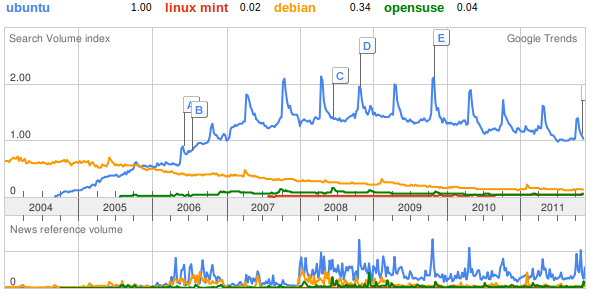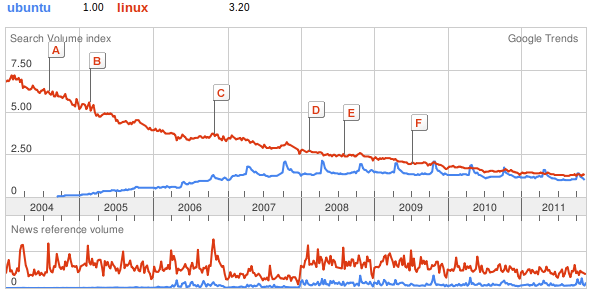Is Ubuntu Still The Most Popular Linux Distro?
Published on by Jim Mendenhall
For the past few years, Ubuntu has been considered the most popular Linux distribution. Recently, there has been a flurry of blog posts claiming that Linux Mint is now more popular than Ubuntu. While Linux Mint seems to have gained greatly in popularity since the first release in 2006, all meaningful statistics (if there is such a thing) point to Ubuntu’s clear lead in usage and popularity.
It’s nearly impossible to tell how many people are using any given Linux distribution. Each distro probably has some internal statistics that they can use to judge relative popularity, but tracking how many people have installed a distro or use it regularly (let alone how much they “like it”) is currently not possible. We can, however look at some general trends online to get an idea of a distro’s relative popularity.
Please Note: this article is in no way a scientific study of distro popularity, it is just a bunch of interesting statistics from around the internet.
Let’s look at some online sources that can give us an idea of the relative popularity of different Linux distros.
DistroWatch.com
Let’s start our search with DistroWatch.com. While clearly not a good indicator of a distribution’s usage or popularity, the site is a traditionally accepted measure of popularity in the Linux community. The statistics published by DistroWatch.com really only tell us how may people visited a distro’s page on the DistroWatch.com site. The recent rise of Linux Mint at DistroWatch.com has been used as the basis of many blog posts by Mint fans and Ubuntu haters to proclaim the end of Ubuntu.DistroWatch.com’s most popular Linux distributions for the past 6 months
- Linux Mint
- Ubuntu
- Fedora
- openSUSE
- Debian
- Arch
- PCLinuxOS
- CentOS
- Puppy
- Mandriva
Website popularity
Netcraft and Alexa are two companies that publish global website ranking statistics. These sites are far from perfect, but give a general idea of relative website popularity. Here are current website rankings of the top distro websites.Netcraft Rankings
Alexa Rankings
- www.ubuntu.com: 1,184
- www.debian.org: 3,335
- www.centos.org: 4,069
- fedoraproject.org: 6,418
- www.OpenSUSE.org: 8,007
- www.linuxmint.com: 8,395
- www.archlinux.org: 14,802
- www.mandriva.com: 36,275
- www.puppylinux.org: 134,334
- www.pclinuxos.com: 89,158
Ubuntu clearly holds the lead in website popularity, but Linux Mint, Debian and CentOS are not far behind.
Blogging Trends
BlogPulse tracks how often people are writing about a certain topic. Ubuntu is still clearly blogged about more often than any other Linux distro. While Linux Mint has recently seen a big increase in blog posts, it still does not compare with amount of posts about Ubuntu.
Google Trends
The Google Trends tool gives us insight into relative search volume for different search terms. Google doesn’t provide exact search numbers, but allows us to compare keywords relative to each other. Lets compare the search volume for different Linux distros.First, let’s compare the top 4 distros from DistroWatch.com. As you can see, Ubuntu is searched for far more often than Linux Mint, Debian and openSUSE.

Now, compare Ubuntu to the rest of the top 10 distros combined. Ubuntu is searched for more often than all the other distros together! However, you can also see a gradual decline in Ubuntu searches over the past couple of years.

Another interesting trend appears when you compare Ubuntu with Linux. At certain times (around new releases), Ubuntu is actually searched for more often than Linux. Does this mean that Ubuntu as an operating system or distro is becoming more popular amongst the general population than Linux?


Facebook Shares
Another interesting statistic we can find online is the number of times a distro’s home page has been shared on Facebook. While clearly not an exact indication of a distro’s popularity, it can give us some idea of how many people share a link to their favorite distro with their friends. The following statistics come from the Facebook Graph API and show links to the distro’s homepage. Ubuntu has a clear lead in Facebook shares, with Linux Mint and Fedora fighting for second.- Ubuntu - 83,945 shares
- Linux Mint - 7,762 shares
- Fedora - 6,313 shares
- Debian - 3,986 shares
- Arch - 1,445 shares
- CentOS - 979 shares
- openSUSE - 599 shares
- PCLinuxOS - 573 shares
- Puppy - 426 shares
- Mandriva - 419 shares
Conclusion
Looking at these general online trends, there seems to be some merit to the idea that Ubuntu is loosing mind share to Linux Mint. While Ubuntu still holds a clear advantage in almost all online indicators, there is a slight downward trend that can be seen. Also, Linux Mint has been steadily gaining ground since it was introduced.What does this mean for the future of Linux distributions? Are users really leaving Ubuntu because of the Unity interface (like many would claim)? Is Linux Mint the distro of the future?
Personally, I think that the competition between the different distros and desktop environments only strengthens the Linux community. Offerings from Linux Mint, openSUSE and Fedora bring their own unique ideas to the Linux world. If Canonical is wise, they will pay attention to these trends, to the latest developments in other Linux distros and use that input to build a better Ubuntu.

